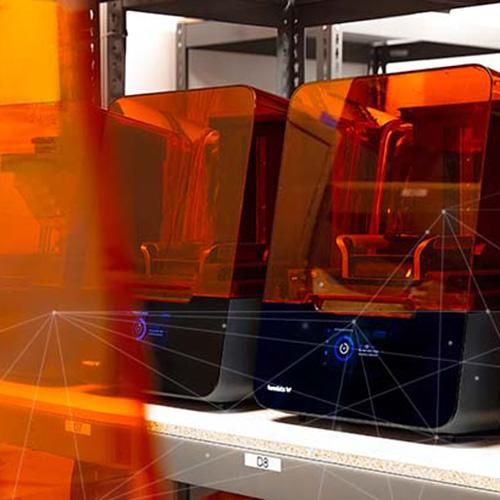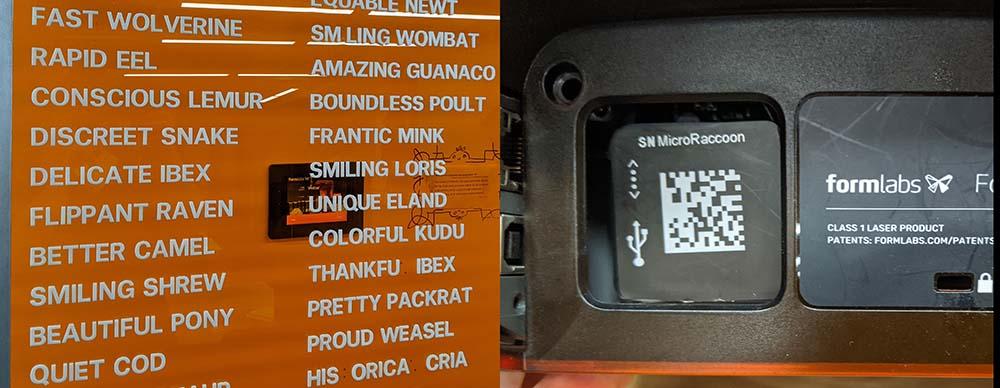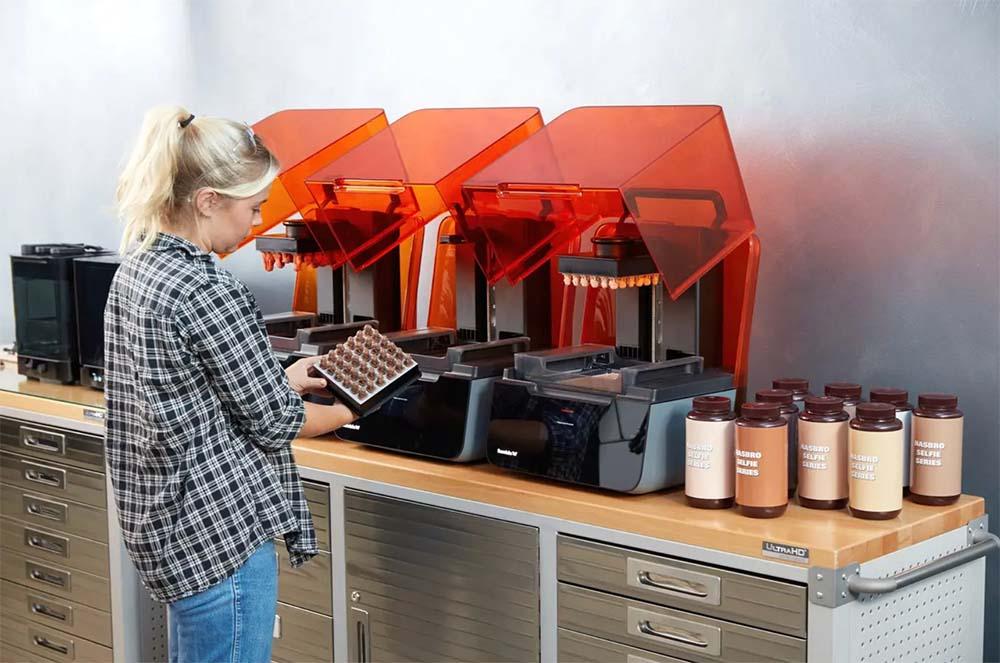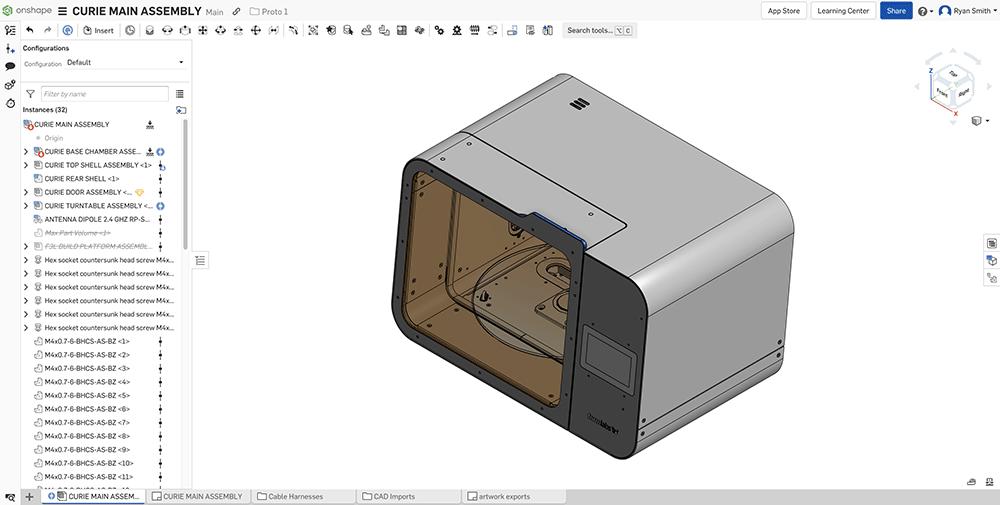The Challenge
Formlabs is a leading global developer of industrial 3D printers used for R&D, rapid prototyping, small batch custom production, and making jigs and fixtures for manufacturing. Headquartered in Massachusetts, the company also has operations in Ohio, North Carolina, China, Germany, Hungary, Japan and Singapore. In 2019, Formlabs was looking for a cloud-native CAD and PDM platform to streamline communication between its teams spread across the world. The file-based data management system they had been using required engineers to check in and check out design files from a vault, forcing them to work one-person-at-a-time, significantly slowing down their product development process.
Results
- Onshape’s real-time CAD collaboration tools enable multiple Formlabs engineers to concurrently work on a design versus being forced into a serial workflow.
- Onshape’s built-in PDM system enables teams around the world to work with a single source of truth, eliminating version control issues during the collaboration process.
- The Formlabs product development team no longer experiences delays due to software crashes or corrupted files due to Onshape’s cloud-database architecture.
- When scaling up projects, Formlabs can grant immediate CAD access to new hires, contractors or external partners by just entering their email address. Waiting days or weeks to purchase new CAD licenses is no longer necessary.



The way Onshape is designed, there is no need to remember to save our designs mid-workflow. It's always being backed up automatically. If a computer crashes, you can just move to another computer and continue right where you left off. The stability of the software has been a great boon to us.’’

If some product engineers and manufacturers get emotionally attached to their Formlabs 3D printers, you’ll have to forgive them.
Instead of mundane serial numbers, Formlabs nicknames each printer with a randomly chosen animal and adjective. Some of the whimsical names, which sound more like exotic pets than additive manufacturing tools, include: SMILING WOMBAT, FLIPPANT RAVEN, BREEZY SHARK, HEAVY BUNNY, MACHO CLAM and PRETTY PACKRAT.
Quirky names aside, Formlabs is a leading global developer of industrial 3D printers, and its own high-performance materials that enable “anyone to make anything.” Headquartered in Massachusetts with offices in Ohio, North Carolina, China, Germany, Hungary, Japan and Singapore, Formlabs aims to be a “manufacturer’s Swiss Army knife.” Its family of printers and post-processing solutions are used not only for R&D and rapid prototyping, but also for small batch custom production, making jigs and fixtures, and to quickly resolve supply chain problems (i.e. making machine replacement parts on demand versus waiting for them to be shipped from overseas).

Formlabs customers include Ford, Google, New Balance, Gillette, Lush Cosmetics, Hasbro, Sony and Marvel Studios, which uses 3D printing for movie props such as Thor’s hammer.
“3D printing has completely changed the way that we think about manufacturing,” notes Matt Lipsitz, Head of Sustaining Engineering and Quality for Formlabs. “Using the traditional subtractive approach, you start with a block of material and you chip away at it in order to make a part. With the additive approach, you build it up layer by layer (with powder or resin) without the same kind of material waste you would have with traditional manufacturing. And what that means is companies can turn more of their raw materials into the finished product than they could ever do before.”
“All our printers are readily accessible, relatively inexpensive, can fit on a desktop, and can ramp up the manufacturing process quickly on a modular level,” he adds. “What really excites me is how Formlabs is making mass customization truly accessible across a wide range of industries.”
The Era of Mass Customization

In the toy world, action figure pioneer Hasbro (which introduced the first poseable G.I. Joes in 1964) recently used Formlabs printers to rapidly create a “mini factory” near their Rhode Island headquarters for production of its on-demand “Selfie Series” figures. Hasbro enables its fan base to scan their faces into an app, choose their hair color and preferred body type and order a fantasy action hero based on their likeness. The toy company urges collectors to “Make Room on Your Shelf for Yourself.”
On a much more personal level, Formlabs Dental Resins and printers are now being used by dental labs and practices to quickly produce biocompatible surgical guides, splints, fixed patterns and models, clear aligner models, and full dentures. In the healthcare industry, Formlabs BioMed Resins and printers are used for a variety of biocompatible applications, including models for medical implant sizing.
“When we think about manufacturing something for a person’s body where everyone is very different, or manufacturing for a particular consumer taste or desire, 3D printing is the perfect solution and can deliver so many valuable benefits,” says Lipsitz. “Additive manufacturing enables product developers to have tangible examples of their designs faster. That means the speed of iteration can accelerate because there are physical prototypes to test and validate earlier without the same kind of time and financial investment required by traditional methods.”
“The world is moving from automated manufacturing that makes the same exact thing many, many times over to automated manufacturing that can make different things many times over – but with comparable efficiency and relatively little investment,” he adds. “And Formlabs is at the forefront of bringing that kind of mass customization to industry.”
Cloud-Native CAD Delivers Better Team Collaboration

To design its 3D printers and post-processing machines, Formlabs relies on Onshape, a cloud-native CAD platform with built-in Product Data Management (PDM) and real-time collaboration tools. Formlabs switched to Onshape from its old file-based CAD and PDM systems in 2019 because their legacy on-premise software slowed down its collaborative design process.
When multiple engineers are working on the same file-based CAD model, they are required to check their work in and out of a PDM “vault” to prevent version control issues – denying visibility to colleagues until they are finished editing. File-based data management platforms force serial workflows, requiring engineers to work one-at-a-time instead of concurrently.
In contrast, cloud-native Onshape’s real-time data management allows multiple engineers to simultaneously work on the same product model, seeing each other’s design changes (or proposed design changes in experimental branches) as they happen. A comprehensive Edit History tracks every design change, who made them and when – allowing the team to instantly revert back to any earlier stage of the design if desired.
“It's critical to reduce waste in any design process,” notes Lipsitz. “And one of the great ways to do that is to know that when you're looking at something, you can trust it is the latest iteration. So any time you have to go back and rebuild a model or redesign something because it wasn't saved correctly, that's a waste. It's hugely valuable for our engineers to know that what they're looking at is the latest version.”
“In my current role, I need to collaborate with people globally. My colleagues or partners might be in the Far East, Europe or across the United States. So I need to be able to show them the latest CAD model in a matter of seconds – and it’s imperative that we’re all working from that same single source of truth,” he adds.
Improved CAD Stability and Reduced IT Overhead

According to Lipsitz, another huge benefit of cloud-native Onshape is the peace-of-mind that design work won’t be lost because of data corruption or computer crashes, issues common with on-premise, file-based systems.
“The way Onshape is designed, there is no need to remember to save our designs mid-workflow,” he says. “It's always being backed up automatically. If a computer crashes, you can just move to another computer and continue right where you left off. The stability of the software has been a great boon to us.”
As a Software-as-a-Service (SaaS) platform, Onshape regularly releases updates in the cloud every three weeks, adding new features and functionalities requiring no downloads or installs.
“With Onshape, there's always continuous improvement. Our engineers get excited to see what new features have come out in the last release and what features we may have requested that were recently deployed,” Lipsitz says. “That iterative cycle is refreshing. It feels like there's always something new – as opposed to an on-premise system that may be updated only once a year.”
“Any time engineers are not actively working on design projects, they’re not adding value to the company. So we want to pursue any ways to eliminate downtime,” he adds. “And cloud-native software takes servers, maintenance and other IT tasks out of our hands, saving time and reducing the burden on our engineers.”
Scaling Up the Formlabs Engineering Team

As Formlabs continues to develop new additive manufacturing technologies and expand its worldwide business, Lipsitz maintains that Onshape will remain especially valuable for helping to accelerate the onboarding process for new engineering hires.
When scaling up a project, Onshape users can grant immediate access to colleagues by simply entering their email address – versus waiting days or weeks to obtain additional CAD licenses with on-premise vendors and requiring assistance from IT.
“Onshape really reduces the barrier to onboarding engineers,” Lipsitz says. “The fact that it's based in the cloud means that we don't need to install any software, and we can add a new user with the click of a button, as opposed to having to install and link to a PDM system, and then teach somebody how to access it. Onshape runs right in your browser so somebody is good to go and can start designing parts right away.”
“We recently realized these same benefits on a project with an overseas supplier who was willing to adopt Onshape for joint engineering development of a new product,” he adds. “The ability to integrate an external partner into our engineering toolset shifted the traditional relationship from a transactional one to a collaborative one.”





